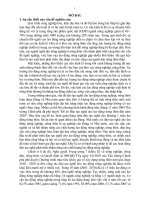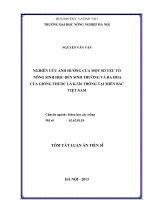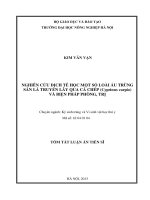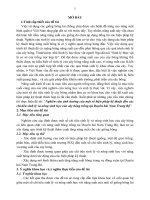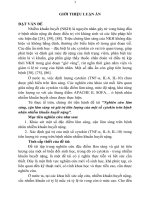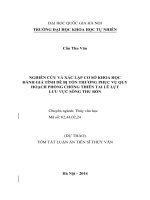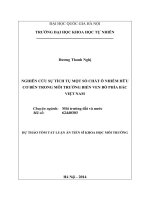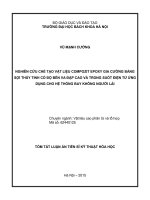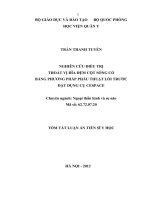Thông tin tóm tắt về những đóng góp mới của luận án tiến sĩ: Nghiên cứu ảnh hưởng của một số phụ gia đến quá trình mạ kẽm, định hướng ứng dụng cho bể mạ kẽm kiềm không xyanua
Bạn đang xem bản rút gọn của tài liệu. Xem và tải ngay bản đầy đủ của tài liệu tại đây (1.89 MB, 26 trang )
<span class='text_page_counter'>(1)</span><div class='page_container' data-page=1>
<b>MINISTRY </b>
<b>OF EDUCATION AND TRAINING</b>
<b>VIET NAM ACADEMY </b>
<b>OF SCIENCE AND TECHNOLOGY</b>
<b>GRADUATE UNIVERSITY OF SCIENCE AND TECHNOLOGY </b>
---
<b>TRUONG THI NAM </b>
Thesis title: <b>STUDYING THE EFFECTS OF SOME ADDITIVES ON THE </b>
<b>ZINC PLATING PROCESS, ORIENTED APPLICATION FOR ALKALINE </b>
<b>NON-CYANIDE ZINC PLATING BATH</b>
<b>SUMMARY OF PHD DISSERTATION </b>
<b>Major: Theoretical Chemistry and Physical Chemistry </b>
<b>Code: </b>
<b>9.44.01.19 </b>
HA NOI 2021
</div>
<span class='text_page_counter'>(2)</span><div class='page_container' data-page=2>
Supervisors: Dr. Le Ba Thang
Assoc. Prof. Dr. Nguyen Thi Cam Ha
The thesis will be defended at the Board of Examiners of Graduate university of
Science and Technology, hanoi. Viet Nam Academy of Science and Technology at
……….. on ………..
</div>
<span class='text_page_counter'>(3)</span><div class='page_container' data-page=3>
The problem of corrosion resistance for metal materials has become an urgent
need for all countries in the world, especially for Vietnam which is located in the
tropical monsoon climate: temperature, High air humidity [1].
Metal coating is one of the methods of corrosion protection that has been
researched and used quite popularly in the world and in Vietnam. Among them, zinc
is one of the most used metal coatings to protect components, parts, machine parts
and carbon steel structures thanks to its low cost, cathodic protection for steel. .
Galvanized coating can be obtained from a variety of methods such as electroplating,
hot dipping, spray coating, where electroplating dominates with small details, is used
in atmospheric conditions and does not require too much longevity. high.
Some of the zinc plating solutions have been studied and used such as: zinc plating
from sulfate solution, fluoride, cyanide, pyrophotphate, chloride and non-cyanide
alkali. Among them, the solutions widely used in industry are cyanide, chloride and
non-cyanide alkali.
The world's cyanide alkali-plated solution was commercialized very early in the
1960s [3]. However, recently, thanks to the introduction of new polishing additive
systems as well as due to environmental protection requirements, this plating tank is
really interested, accepted and becomes the best solution to change. cyanide plating
tank. The non-cyanide alkaline zinc plating solution has some outstanding advantages
such as: more economical, non-toxic, good coating quality, easy to pass, especially
suitable for passive solutions of Cr (III), good throwing power, especially easy to
handle wastewater [2, 4]. The downside is more complex, which requires a good
surface treatment.
However, if the alkaline plating bath is free of cyanide without additives, the poor
quality coating cannot be used in industry. Many organic and inorganic additives
introduced at relatively low concentrations can alter zinc precipitation, coating
structure, morphology, and properties. One added additive can affect many properties
of the coating, but in reality many additives are still added at the same time because
they need their synergy. They make the coating smooth, flat, increase throwing
power, have a nice gloss, work at a wide current density [3, 5-24].
</div>
<span class='text_page_counter'>(4)</span><div class='page_container' data-page=4>
In the country, the study of additive systems for zinc plating in general and alkali
galvanizing in particular has not been given adequate attention. There is no official
research result published on the effects of these factors on the zinc plating process in
general and the non-cyanide alkali galvanizing process in particular, and no supplier
has given an additive system. for non-cyanide alkaline galvanizing tanks.
Stemming from the above domestic situation, the selection of the topic: "<i><b>studying </b></i>
<i><b>the effects of some additives on the alkaline non-cyanide galvanizing process, </b></i>
<i><b>orienting the fabrication of the additive system for alkaline non-cyanide zinc </b></i>
<i><b>plating bath</b></i>, oriented to the fabrication of the additive system for the alkaline
galvanized tank "Meeting the practical needs, the research direction can create a
product oriented application for the domestic alkali galvanizing industry, and at the
same time add insights to support the galvanizing businesses."
<b>2.</b> <b>Research aims and objectives</b>
Determining the effect of the single additive being organic and inorganic
substances such as poly alcohol, poly amines, sodium salt of various modules and the
combination of additives on the properties of the zinc coating created in the solution.
alkaline plating solution without cyanide, compare the chemical and physical
properties of the coating obtained from the non cyanide alkaline plating bath and
other plating baths. Since then, an additive system can be used in alkaline zinc-plated
tanks without cyanide
<b>3. Main research content </b>
1. Investigate the effects of the single additive on the throwing power capacity,
current efficiency, cathode polarization, working current density range, surface
morphology, gloss of the zinc coating.
2. Investigate the effects of the combination of additives on the throwing power
capacity, current efficiency, cathode polarization, working current density range,
surface morphology, and gloss of the zinc coating from there. an additive system that
can be used for alkaline non-cyanide zinc plating bath.
3. Determine the mechanism of action of the additives on zinc precipitation and some
properties of the coating in the alkaline non-cyanid zinc plating bath
<b>CHAPTER 1. INTRODUCTION </b>
</div>
<span class='text_page_counter'>(5)</span><div class='page_container' data-page=5>
used with other polishing agents especially heterocyclic nitrogen compounds with at
least one substituent group to improve coating properties. In 1979, in their invention,
Zehnder and Stevens [29] used polyamin sulpho with very different concentrations
from 0.1 to 100g / liter, combined with pyrydin compounds or nicotine content of a
few g. / liter to improve galvanizing properties, in alkali-free cyanide baths. However,
pyrydin compounds are known to be very toxic volatiles, affecting the health of those
working in the surrounding environment. In recent years, there are quite a few
inventions and works published about additives for alkaline galvanized tanks
[2-7,12-21,23,26-32]. Substances used as additives for alkaline galvanizing tanks belong to
such lines as: alcohol polymers, polymers of level 1 to 4 amines, heterocyclic
compounds, surfactants, benzanaldehyde, poly alcohol or heterocyclic nitrogen
compounds have a substituent group of sulfide, reducing sugars, sodium salts, and a
number of complexing agents are used together, in each case, to improve the coating
properties, to change precipitation properties, crystal smoothing, wetting agent,
polishing agent. In general, commercial products are used well, the stability system
is not much, the system composition is quite complex, often consisting of 4
components.
</div>
<span class='text_page_counter'>(6)</span><div class='page_container' data-page=6>
<b>CHAPTER 2.MATERIALS AND METHODS </b>
<b>2.1. Sample preparation, chemicals and equipment </b>
<i><b>2.1.1. Research materials </b></i>
Test sample: low carbon steel has different sizes depending on the test.
Research steel equivalent to SPHC grade according to JIS G3131 standard<b>. </b>
<i><b>2.1.2. Sample preparation </b></i>
<b>Table 2.2. Types of test samples and intended use </b>
<b>TT </b> <b>Size, shape </b> <b>Uses </b>
1 50 x 50 x 1,8 mm SEM, XRD, IR, current efficiency determination
2 40 x 40 x 1,8 mm Throwing power of determination
3 70 x 100 x 1 mm Test of Hull
4 10 mm; electric wire
welding, epoxy coated Cathode polarization, CV
<i><b>Table 2.3. </b></i>Sample creation process
<b>TT </b> <b>step </b> <b>Conducting conditions </b>
1 Polished Sandpaper No 100 to No 600
2 Degreasing Solution 60 g/L UDYPREP-110EC (ENTHONE), -temperature : <sub>50 ÷ 80 oC, time 5 ÷ 10 minute. </sub>
3 Pickling of
rust
Solution HCl 10% thể tích, urotropin 2-3 g/L, time 2 ÷ 5 minute
4 Activation Solution HCl 5% volume, time 10÷ 15 seconds
5 plating Zinc plating solution
<i><b>2.1.3. Test solution. </b></i>
- Alkaline non-cyanid zinc plating solution S0 have ingredients are as follows:
NaOH: 140 g/L ZnO: 15 g/L
- Other test solutions were based on S0 solution and added with polyamine
(poliethyleneimin), polyvinyl alcohol, and natrisilicate with different concentrations.
The chemical used is pure (China) and mixed with distilled water.
<i><b>2.2. Equipment </b></i>
- Plating bath made of PP plastic, capacity 20 liters,- Electrolytic machine, 12V-30 A
- Hulls cell, 250 ml, - Haring-Blum cell, 400 ml
- Analytical balance, technical balance SHIMADZU AEG-220G with accuracy 0.1
mg
</div>
<span class='text_page_counter'>(7)</span><div class='page_container' data-page=7>
<b>2.3. Methods of analysis </b>
<i><b>2</b></i>.3.1. Hull method.
2.3.2. Haring-Blum methob
2.3.3. Method of determining cathode current efficiency
2.3.4. Measure cathode polarization curve.
2.3.5. SEM –Scanning Electron Microscope.
2.3.6. Fourier FTIR transform infrared spectroscopy method
2.3.7. Measuring ring polarization
<b>CHAPTER 3. RESULTS AND DISCUSSION </b>
The polymers that can be used as additives to the non-cyanide alkaline zinc
plating system must be soluble in the plating solution, depending on the molecular
weight that the solubility in the alkali galvanizing solution changes or does not
dissolve.
After investigating the solubility of polymers it is found that polymers should
only be studied at concentrations from 0.05 g / L to 1.0 g / L to ensure they are
completely dissolved in the plating solutions. The insoluble additives in the plating
solution can become impurities, causing precipitates to enter the coating, which can
affect the coating quality.
<b>3.1.</b> <b> Effects of Polivinyl ancol (PVA) to zinc plating process </b>
PVA has the ability to complex with metal ions and adsorb on metal surfaces
when there is an electric current by the carbon-oxygen bonding polarization in the
molecular structure, so PVA is used by many authors as auxiliary. surface leveling
for plating systems. Quite a few publications mention the use of PVA as an additive
to alkaline non-cyanide zinc plating bath
<i><b>3.1.1.</b></i> <i><b>Effects of the molecular weight of PVA on cathodic polarization. </b></i>
</div>
<span class='text_page_counter'>(8)</span><div class='page_container' data-page=8>
<i><b>Fig 3.1. </b></i><b>Effect of </b><i><b>PVA - 05</b></i><b> on </b>
<b>cathodic polarization</b><i><b>, from 1.2 to </b></i>
<i><b>-1.8 V, sweep speed 2 mV / s , 25</b><b>0</b><b><sub>C</sub></b></i>
<i><b>Fig 3.2. </b></i><b>Effect of </b><i><b>PVA - 16</b></i><b> on </b>
<b>cathodic polarization</b><i><b>, from 1.2 to </b></i>
<i><b>-1.8 V, sweep speed 2 mV / s , 25</b><b>0</b><b>C</b></i>
These plots were swept from the open current potential towards the negative
direction at a scan rate of 2 mV/s. In all cases, the polarization curves were
characterized by appearance of the first cathodic peak (I) followed by either rapid rise
in current density for plating bath without PVA or the second cathodic peak (II) for
plating baths containing PVA. There was little difference between PVA plating baths
at concentrations of 1.0 and 1.5 g/L.
For the plating bath without PVA, the cathodic polarization plot had a peak I
followed by rapid growth in current density. It was assigned to the reduction of Zn2+
to Zn that is corresponding to the reaction below:
Zn(OH)42-<sub> + 2e</sub>-<sub> ↔ Zn + 4OH</sub>- <sub>(3.q) </sub>
The following four step reaction path has been proposed for the deposition of zinc
from zincate solution where reaction (iii) as the rate determining step [13]:
Zn(OH)42- ↔ Zn(OH)3- + OH- (3.2)
Zn(OH)3- + e- → Zn(OH)2- + OH- (3.3)
Zn(OH)2- ↔ ZnOH + OH- (3.4)
ZnOH <sub>+ e</sub>-<sub> → Zn</sub> <sub>+ OH</sub>- <sub>(v) </sub>
Since Zn2+ <sub>preferred to exist as a tetra or hexa-coordinate species, the coordinated </sub>
Zn(OH)3-<sub> is more likely to exist as Zn(OH)3(H2O)</sub>-<sub>, thus step (3.3) became as (3.4) </sub>
below:
Zn(OH)3(H2O)- + e- → Zn(OH)2- + OH- + H2O (3.6)
It was also possible that PVA replaced the presence of H2O in the complex
Zn(OH)3(H2O)- as step (vii).
Zn(OH)3(H2O)-<sub> + PVA ↔ Zn(OH)3(PVA)</sub>-<sub> + H2O </sub> <sub>(3.7) </sub>
Hence, energy is needed to break the PVA complex to deposit zinc on steel
surface. It might be the reason of appearance of the peak II.
</div>
<span class='text_page_counter'>(9)</span><div class='page_container' data-page=9>
because PVA owed to the polarity of the carbon-oxygen bond. Consequently, leveling
effect was formed on surface.
However, these hypotheses should be investigated by further studies.
<i><b>3.1.2.</b></i> <i><b>Study the effect of the additives in the plating process by method </b></i><b>cyclic </b>
<b>voltammogram</b>
<i>a. Study the effect of PVA in the plating process by method cyclic voltammogram </i>
Polarization curves were measured in PVA-containing and non-PVA
zinc-plating solutions to study the effect of PVA on potential values and maximum
currents..
<b>Table 3.1. Potential values, excesses and currents at the pips of the </b>
<b>plating in a solution with and without PVA</b>
ECo
VAg/AgCl
(V)
EI’c
VAg/AgCl
(V)
EI’c
VAg/AgCl
(V)
∆𝐸’c
(V)
∆E”c
(V)
Ip(I’c)
(mA/cm2<sub>) </sub>
Ip(I”c)
(mA/cm2<sub>) </sub>
So -1,48
Sp2-4 -1,48 -1,54 -1,65 -0,06 -0,17 -27,35 -30,90
<i><b>Fig 3.3. Cyclic voltammogram of the </b></i>
<i><b>steel electrode was measured in alkaline </b></i>
<i><b>zinc plating solutions without additives </b></i>
<i><b>from -1.2 to -1.65 V, with a scan rate of </b></i>
<i><b>2 mV/s, at 25°C </b></i>
<i><b>Fig 3.4. Cyclic voltammogram of the </b></i>
<i><b>steel electrode was measured in alkaline </b></i>
<i><b>zinc plating solutions with and without </b></i>
<i><b>PVA-16 from -1.2 to -1.65 V, with a scan </b></i>
<i><b>rate of 2 mV/s, at 25°C </b></i>
</div>
<span class='text_page_counter'>(10)</span><div class='page_container' data-page=10>
<i><b>Fig 3.5. Cyclic voltammogram of the steel </b></i>
<i><b>electrode was measured in alkaline zinc </b></i>
<i><b>plating solutions (S0) -1,2 to -1,65 V, tốc </b></i>
<i><b>canning rate change, 25</b><b>0</b><b>C </b></i>
<i><b>Fig 3.6. Graph of the dependence of </b></i>
<i><b>i on v</b><b>1/2 </b><b><sub>scan in alkaline zinc plating </sub></b></i>
<i><b>solutions (S0) </b></i>
Research results of the study on the effects of PVA on the galvanizing process
in non-cyanide alkali galvanizing solutions by the ring polarization scanning method
showed that the presence of PVA in the plating solution increases the potential in
plating solution at the same time reducing the current density at the adsorption peaks.
The results show that the presence of PVA in the plating solution makes the slope
a (reflecting diffusion coefficient D) of the line i dependent on v1/2<sub>, it can be said that </sub>
PVA-05 and PVA- 16 both increase the diffusion potential in the plating solution.
The ability of the additive to cover surface (Ꝋ) is calculated by the formula:
Ꝋ =
𝑖−𝑖
𝑠𝑖
(3.8)
Where i is the current density without additives, is the current density without
additives. Impact level Ꝋ is determined at the potent at -1,65 for results Table 3.2.
<b>Table 3.2. Coverage of PVA </b>
Dung dịch Ꝋ Ꝋ1 Ꝋ2 D
S0 2,446
Sp1-4 0,53 0,55 0,23 -112,9
Sp2-4 0,67 0,61 0,47 -128,9
The results showed that PVA adsorbs the cathode surface at convex peaks, this
adsorption process prevents metal precipitation at the protrusion points, metal
precipitates at the convex peaks decrease, the metal will precipitate at adjacent
concave positions to level the surface.
This adsorption process also reduces the rapid increase in particle size, when the
metal precipitates at a point, that point will rise higher, and react (3.9):
Zn2+<sub> + 2e</sub>-<sub> = Zn (3.9) </sub>
</div>
<span class='text_page_counter'>(11)</span><div class='page_container' data-page=11>
surrounding position, PVA molecule has negative polarized OH (OH -) will go to the
surface adsorption to the surface to hinder the precipitation process, the particle size
does not increase, but more new particles appear in the vicinity, this process produces
seeded seeds with size Small smooth, coating surface more even.
<b>3.2.3</b>. <i><b>Effect of molecular weight PVA on the zinc plating process (Hull method</b></i>)
The Hull method shows that when adding PVA to plating solutions with different
concentrations, it has the effect of smoothing crystals compared to coatings in
solutions that do not contain PVA.
As the PVA concentration increases, the surface of the zinc precipitate becomes
smoother, the gloss and gloss are enlarged. It can be explained that in the presence of
PVA, the reaction (3.6) was changed. PVA can replace the presence of H2O in Zn
(OH)3 (H2O-<sub>) and become Zn(OH)3(PVA)</sub>-<sub> as in reaction (3.7) above. As a result, the </sub>
reaction (3.6) becomes (3.10) below:
Zn(OH)3(PVA)- + e → Zn(OH)2- + OH- + PVA (3.10)
Assuming that the reaction (3.10) is much slower than (3.6) due to the energy
required to break the PVA complex, will explain PVA's seed crystal smoothing
properties in the plating solution [12]. The results of the study on the influence of
PVA on the plating process by Hull method, the results are consistent with the
polarization curves. If the PVA concentration increases, the Zn(OH)3 (PVA) complex
- produces more and therefore the zinc precipitate requires more energy to break down
the complex, leading to a decrease in the galvanic current density in the plating
sample in the capacitance. solution with high PVA concentration.
<i><b>Fig 3.14. Hull cell pattern obtained from </b></i>
<i><b>alkaline non-cyanide bath containing </b></i>
<i><b>PVA-05 with various concentrations</b></i>
<i><b>Fig 3.15. Hull cell pattern obtained </b></i>
<i><b>from </b></i> <i><b>alkaline </b></i> <i><b>non-cyanide </b></i> <i><b>bath </b></i>
</div>
<span class='text_page_counter'>(12)</span><div class='page_container' data-page=12>
<i><b>3.1.3.</b></i> <i><b>Effect of molecular weight PVA to SEM images of the sample plated in </b></i>
<i><b>alkaline bath. </b></i>
<i><b>Fig 3.16. SEM images of the sample plated in alkaline bath </b></i>
<i><b>PVA – 05, 0,5 A/dm</b><b>2</b></i>
The presence of PVA-16 and PVA-05 in the plating solution reduces the particle
size, changes SEM images, semi bright.
<i><b>3.1.4.</b></i> <i><b>Effect of molecular weight PVA to throwing power and performance </b></i>
a. <i>Effect of molecular weight PVA tothrowing power. </i>
<b>Table 3.7. Throwing power </b>
<i>TT </i> <i>C (g/L) </i> <i>Throwing power(0,5 A/dm</i>
<i>2<sub>) </sub></i> <i><sub>Throwing powerở (2 A/dm</sub>2<sub>) </sub></i>
<i>PVA-05 </i> <i>PVA - 16 </i> <i>PVA-05 </i> <i>PVA - 16 </i>
1 0 30,2 30,2 25,9 25,9
2 0,05 40,1 42,7 37,8 40,6
3 0,10 47,9 44,1 44,9 49,2
4 0,25 62,3 55,8 56,3 52,1
5 0,50 64 76,2 64,7 64,3
6 1,0 72,2 77,2 70,9 70,3
Table 3.9 results show that adding PVA in plating solution increases the throwing
power of the plating process. The distribution increase is highly dependent on the
PVA concentration in the plating solution, while less dependent on the working
current density.
PVA-16 has greater molecular mass than PVA-05, and also has a greater impact
on throwing power than PVA-05.
</div>
<span class='text_page_counter'>(13)</span><div class='page_container' data-page=13>
<b>Table 3.10. Performance of plating system with and without PVA </b>
<i>TT </i> <i>C (g/L) </i> <i>performance (0,5 A/dm</i>
<i>2<sub>) </sub></i> <i><sub>performance</sub><sub> (2A/dm</sub>2<sub>) </sub></i>
<i>PVA -05 </i> <i>PVA - 1600 </i> <i>PVA-05 </i> <i>PVA - 1600 </i>
1 0 80,7 80,7 79,2 79,2
2 0,05 72,7 73,9 39,91 56,65
3 0,10 67,1 69,3 23,53 41,8
4 0,25 49,08 55,8 11,59 19,89
5 0,50 34,92 36,2 7,56 9,15
6 1,0 15,93 15,2 7,18 7,43
The presence of PVA reduces plating efficiency.
<b>3.2.</b> <b>Effect of BT on the galvanizing process </b>
<i><b>3.2.1.</b></i> <i><b>Effect of BT on cathodic polarization </b></i>
The polarization lines are measured in alkakine on-cyanide zinc plating solution
with and without BT variable molecular and concentration to evaluate of BT on
plating process.
<i><b>Fig 3.20. Effect of BT on cathodic polarization, -1,2 to -1,8V, 2mV/s, 25</b><b>0</b><b>C</b></i>
The results showed that, the BT with different molecular weights, added to the
plating solution at the same concentration, the BT has a higher molecular weight than
BT-200, BT-700, has less effect on polarization. cathode than BT with low molecular
weight BT-12, BT-18 (Fig 3.21). Due to the same concentration, the low molecular
weight exercises contain more molecules, participating in the reaction at more
locations..
</div>
<span class='text_page_counter'>(14)</span><div class='page_container' data-page=14>
<b>Table 3.9. Peak values of </b>
<b>galvanizing process in solution with and without BT-18</b>
solution ECo
VAg/AgCl
(V)
EI’c
VAg/AgCl
(V)
EI’c
VAg/AgCl
(V)
ȠI’c
(V)
ȠI”c
(V)
Ip<i>(I’c) </i>
mA/cm2
Ip<i>(I”c) </i>
mA/cm2
S0 -1,48
SB2-1 -1,48 -1,52 -1,59 -0,04 -0,11 27,70 40,7
SB2-2 -1,48 -1,52 -1,56 -0,04 -0,08 18,60 43,18
SB2-3 -1,48 -1,53 -1,59 -0,05 -0,05 32,70 39,76
SB2-4 -1,48 -1,53 -1,6 -0,05 -0,05 30,90 41,58
SB2-5 -1,48 -1,52 -1,65 -0,04 -0,04 18,50 43,10
<i><b>Fig 3.23. Cyclic voltammogram of the steel electrode was measured in alkaline </b></i>
<i><b>zinc plating solutions (S0)+ BT-700, -0,5 đến -1,65 V, 2 mV/s, 25</b><b>0</b><b><sub>C </sub></b></i>
<b>Table 3.10. Peak values of </b>
<b>galvanizing process in solution with and without BT-700</b>
Solution ECo
VAg/AgCl
(V)
EI’c
VAg/AgCl
(V)
EI’c
VAg/AgCl
(V)
ȠI’c
(V)
ȠI”c
(V)
Ip<i>(I’c) </i>
mA/cm2
Ip<i>(I”c) </i>
mA/cm2
S0 -1,48
</div>
<span class='text_page_counter'>(15)</span><div class='page_container' data-page=15>
<i><b>Fig 3.26 Cyclic voltammogram of the </b></i>
<i><b>steel electrode was measured in </b></i>
<i><b>alkaline zinc plating solutions (S0)+ </b></i>
<i><b>BT-700 -1,2 to -1,65 V, tốc canning </b></i>
<i><b>rate change, 25</b><b>0</b><b><sub>C</sub></b></i>
<i><b>Fig 3.27. Graph of the dependence of </b></i>
<i><b>i on v</b><b>1/2 </b><b>scan in alkaline zinc plating </b></i>
<i><b>solutions (S0)+ BT-700 </b></i>
<b>Table 3.11. Values on the </b><i><b>graph of the dependence of i on v</b><b>1/2 </b><b><sub>scan in alkaline </sub></b></i>
<i><b>zinc plating solutions (S0)+ BT-700</b></i>
R2 Coefficient a (reflects
diffusion coefficient D)
b
S0 0,9942 244,6 -6,3
SB2-4 0,9499 -181,3 0,045
SB4-4 0,9678 -77,7 5,63
The results show that the presence of BT in the plating solution makes the slope
a (reflecting coefficient D) of the dependent line of i in v1 / 2, it can be said that
BT-18 and BT 700 both increase the diffusion potential in the plating solution.
<b>Table 3.12 Coverage of BT </b>
Solution Ꝋ Ꝋ1 Ꝋ2 D
S0 244,6
SB2-4 0,49 0,37 0,25 -181,3
SB4-4 0,61 0,56 0,43 -77,7
Table 3.12 shows that BT adsorb the cathode surface at convex peaks, this
adsorption process prevents metal precipitation at the protruding points, the metal
precipitates at the convex peaks is reduced, the metal will precipitate at adjacent
concave positions to level the surface.
This adsorption process also prevents the rapid increase in particle size, when the
metal precipitates at a point, the point will rise higher, and the reaction occurs(3.9):
</div>
<span class='text_page_counter'>(16)</span><div class='page_container' data-page=16>
At the current density at that location lower than the surrounding locations, the
precipitated zinc position will have a more positive charge than the surrounding
positions, the BT molecule has the function group -N = has double Free electrons will
go to, adsorbed on the surface to hinder precipitation, the particle size does not
increase, but more new particles appear in the vicinity, this process creates seed plated
with small size smooth, coating surface more even.
BT with larger molecular weight has higher coverage than BT with smaller
molecular weight.
Studying the stability of the plating process in a solution containing polyamide
additive
Measurement of the 10-sweep polarization curve in the plating solution
containing BT, the results show that from round 1 to round 6 the peak height
decreases, this shows that in the first scan the coating still has convex peaks, Convex
vertices are leveled after sweep rings. After the 5th round of scanning, the rings from
6, 7, 8, 9, 10 have the same peak heights, this shows that the coating surface has
become flat after 5 rounds of scanning..
<i><b>3.3.4. Effect of molecular weght BT to brightness and bright range (Hull) </b></i>
<i><b>Fig 3.29. Hull cell pattern obtained </b></i>
<i><b>from BS containing BT-12 </b></i>
</div>
<span class='text_page_counter'>(17)</span><div class='page_container' data-page=17>
<b>Table 3.13. Effect of the number of substituents and molecular weight of </b>
<b>polyamines on brightness and bright ranges of zinc deposits in non-cyanide </b>
<b>alkaline plating bath </b>
<i>TT </i>
<i>Additive </i>
<i>content </i>
<i>(g/L) </i>
<i>Semi-bright ranges (A/dm2<sub>) </sub></i> <i>The highest brightness of </i>
<i>samples at 60° </i>
<i>BT-700 BT20 </i> <i>BT-18 BT-12 BT-700 BT20 </i> <i>BT-18 BT-12 </i>
1 0,00 0,0 0,0 0,0 0,0 0,0 0,0 0,0 0,0
2 0,05 0,0 < 6,0 < 2,0 < 1,0 0,0 2,6 2,1 1,4
3 0,1 0 0,0 < 6,5 < 5,5 < 3,0 0,0 4,3 4,0 3,7
4 0,25 <5 <5,0 < 5,5 < 4,0 11,6 7,2 8,3 5,4
5 0,5 0 0,7÷10 <7,0 < 4,0 < 5,0 51,4 39 15,7 9,5
6 1 ,00 <10 Cả tấm < 3,0 <10,0 56,7 38,0 14,0 6,1
The BT is added to the alkali galvanizing solution at a concentration of 0.05 g /
L for a smoother coating, which looks more uniform at variable current densities, a
better coating distribution on the Hull plate than coating in alkaline zinc solution
without BT. When increasing the BT concentration in the plating solution to 0.1; 0.25;
0.5; 1.0 g / L coating on the Hull plate has a wider semi-gloss, in the gloss semi-gloss
area increases. BT with low molecular weight BT-12, BT-18 affects the surface
leveling process, the crystal smoothing is less than BT with high molecular weight
BT-200, BT-700.
BT-200 is added to the plating solution at a concentration of 1 g / L semi-gloss
over the entire Hull plate. However, the measured glossiness is reduced compared to
the 0.5 g / L sample.
Effect of BT on coating glossiness of: BT-700, BT-200> BT-18, BT-12.
</div>
<span class='text_page_counter'>(18)</span><div class='page_container' data-page=18>
the area of flow density where these additives are most effective. Select current
density of 0.50 A / dm2<sub> and 5.0 A / dm</sub>2<sub> for further studies </sub>
<b>3.3.5.</b> <b>Effect of BT to SEM images </b>
<i><b>Fig 3.40. SEM images of the sample plated in alkaline bath </b></i>
<i><b>BT – 700, 0,5 A/dm</b><b>2</b></i>
The results show that the high molecular weight polyamide BT-12 and BT-18
affect the surface morphology, the larger, the low molecular weight polymins
BT-200 and BT-700. Image Figs of the coating in an additive-free solution at current
densities of 0.5 A / dm2<sub> and 5.0 A / dm</sub>2<sub> (M0) show that, when plating in an </sub>
additive-free solution, the image current density greatly affects the seedling size
<i><b>3.3.6.</b></i> <i><b>Effect of molecular and concentration BT to performance and Throwing </b></i>
<i><b>power </b></i>
<i>a. Effect of molecular and concentration BT to performance<b> </b></i>
<b>Table 3.14. Effect of molecular and concentration </b>
<b>BT to performance </b>
<b>TT </b>
<b>Additive </b>
<b>content </b>
<b>(g/L) </b>
<b>performance (0,5 A/dm2<sub>) </sub></b> <b><sub>performance</sub><sub> (5 A/dm</sub>2<sub>) </sub></b>
<b>BT-12 BT-18 </b> BT-<b>200 BT-700 BT-12 BT-18 </b> BT-<b>200 BT-700 </b>
1 0,0 80,7 80,7 80,7 80,7 79,2 79,2 79,2 79,2
2 0,05 25,5 23,8 81,8 59,8 28,1 27,8 39,3 70,9
3 0,1 0 19,2 19,1 79,4 57,4 25,3 27,2 35,3 47,1
4 0,25 18,1 18,3 63,6 53,3 21,1 22,4 31,1 31,4
5 0,50 17,2 18,3 58,2 46,3 17,6 17,2 25,9 22,2
6 1,0 14,1 16,7 46,1 36,7 17,1 16,9 22,1 21,9
The presence of BT in the plating solution, it reduces the plating performance
compared to the plating sample in a polyamide-free plating solution..
</div>
<span class='text_page_counter'>(19)</span><div class='page_container' data-page=19>
<b>Table 3.15. Effect of molecular weight and concentration BT </b>
<b> to throwing power </b>
<i>TT </i> <b>Additive </b>
<b>content</b><i> (g/L) </i>
<i>Throwing power(0, 5A/dm2<sub>) </sub></i>
<i>(%) </i>
<i>Throwing power (5 A/dm2<sub>) </sub></i>
<i>(%) </i>
<i>BT-12 BT-18 BT-200 BT-700 BT-12 BT-18 BT-200 </i> <i></i>
<i>BT-700 </i>
1 0,0 80,7 80,7 30,2 30,2 25,9 25,9 25,9 25,9
2 0,05 38,2 38,9 37,5 48,4 38,6 41 37,2 41,8
3 0,10 39 39,2 38,8 49,5 39,8 42,9 39 42,4
4 0,25 44,9 45 42,5 58,3 45,3 45,6 43,1 43,6
5 0,50 51 50,5 49,6 60,8 53,7 51,2 52,6 46,3
6 1,0 58,7 60,1 60 66,6 62,1 59,3 61,3 49,1
Table 3.15. It was shown that when poliamin was added to plating solution with
different concentrations and molecular weights increased distribution compared to
plating in non-BT plating solutions.
The increase in distribution depends much on the concentration, molecular
weight and on the BT working current density in the plating solution. When plating
at a high working current density, the distribution is inferior to that of a seedling at a
low working current density.
<b>3.4.</b> <b>Effect of natrisilicate and polyamide - natrisilicate system on zinc plating </b>
<b>process. </b>
<i><b>3.4.1.</b></i> <i><b>Effect of natrisilicate and polyamide - natrisilicate</b></i> <i><b>on cathodic polarization </b></i>
After researching, the effect of molecular weight and polyamide concentration on
zinc plating in alkaline plating bath without cyanide, BT-700 concentration 0.5 g / L
was selected as the base additive. Poliamin BT-700 crystal smooth, for semi-gloss
coating, high measured gloss, about 0.8 to over 10.2 A/dm2<sub> semi-gloss. However, the </sub>
coating surface is not uniform, the test should be conducted very carefully because it
is very sensitive and difficult to use in industry. Plating in the plating solution
contains only additive BT-700 for low cathode efficiency, at a current density range
<0.8 A /dm2<sub> the dark coating, so it is necessary to combine with a second additive to </sub>
increase stability. of the base additive in the plating system, increasing the plating
efficiency and extending the semi-gloss towards the low current density.
</div>
<span class='text_page_counter'>(20)</span><div class='page_container' data-page=20>
not change the zinc precipitation substitution, while the polyamide shifts the
precipitation potential of zinc to a more negative side, từ -1.48 lên -1.62 V (Fig 3.43a).
<i><b>Fig 3.43. Effect of natri silicate and polyamide – natri silicate on cathodic </b></i>
<i><b>polarization -1,2 đến -1,8 V, tốc độ quét 2 mV/s, 25</b><b>0</b><b><sub>C </sub></b></i>
The results showed that when the concentration of natrisilicate in the plating
solution increases, the cathode polarization increases. Measurement in a plating
solution with a natrisilicate concentration of maximum 8 g / L for maximum polarity.
The addition of 8 g / L natrisilicate to the alkaline galvanizing solution showed
that cathode polarity increased as the natrisilicate modulus increased. The
polarization lines measured in alkaline zinc solutions with poliamin and natrisilicate
of different modules have an adsorption peak, the absorption peak shifts to a more
negative direction when the natrisilicate modulus is increased..
<i><b>3.4.3</b></i> <i><b>Ảnh hưởng của poliamin và natrisilicat đến độ bóng và khoảng bóng lớp </b></i>
<i><b>mạ kẽm trong bể mạ kiềm không xyanua theo phương pháp Hull. </b></i>
</div>
<span class='text_page_counter'>(21)</span><div class='page_container' data-page=21>
<i>Row 1: Hull sample plated in corresponding solutions, (b) S0: NaOH solution 14 g / L + ZnO </i>
<i>15 g / L, (a) SB4-4 solution S0 + 0.51 g / L BT- 700, (c) Solution S0 + 4 g / L natrisilicate, </i>
<i>Row 2: Hull samples plated in the respective solutions, (d) Mn1-1: S0 + 4 g / L modulus </i>
<i>natrisilicate 1 (e) Mn1-2: S0 + 8 g / L modulus natrisilicate 1, (f) Mn1 -3: S0 + 16 g / L modulus </i>
<i>natrisilicate 1, </i>
<i>Row 3: Hull samples plated in the corresponding solutions, (d) Mn2-1: S0 + 4 g / L modulus </i>
<i>natrisilicate 2,5 (e) Mn2-2: S0 + 8 g / L modulus natrisilicate 2,5, (f) Mn2-3: S0 + 16 g / L modulus </i>
<i>natrisilicate 2,5, </i>
<i>Row 4: Hull samples plated in the corresponding solutions, (d) Mn3-1: S0 + 4 g / L modulus </i>
<i>natrisilicate 3 (e) Mn3-2: S0 + 8 g / L modulus natrisilicate 3, (f) Mn3 -3: S0 + 16 g / L modulus </i>
<i>natrisilicate 3, </i>
The research results show that poliamin acts on all research properties, for the
galvanizing process in alkaline plating baths without cyanide. While natrisilicate only
affects some properties of the plating process.
Poliamin increases cathode polarization and shifts the precipitation potential of
zinc to a more negative side from -1.48 to -1.62 V. Natrisilicate affects only cathode
polarization but does not change the zinc precipitation potential.
The Hull method shows the presence of polyamide in crystal smoothing solution,
semi-gloss coating on almost the entire Hull sheet. Adding natrisilicate creates a
brighter and more uniform coating.
The study of surface morphology showed that adding more poliamin, the particle
size decreased sharply and there was no grain. The particle size is about 5 to 7 µm in
the plating sample in a solution not contained in polyamide to a flat surface with no
visible particles in the plating sample in the polymer addition solution. Adding only
natrisilicate did not significantly reduce the size of the particles. However, more
uniform particles were found. The addition of natrisilicate and in the plating solution
containing polyamide more uniformity is observed on the coating surface.
The addition of natrisilicate has little effect on the plating efficiency but
significantly increases the coating throwing power.
After the study, the 2-component additive system was selected as follows:
<b>Table 3.20. Thesis additive system and parameters of the system </b>
<i>poliamin </i> <i>Natrisilicat </i> <i>Khoảng </i>
<i>bóng </i> <i>Độ bóng </i>
<i>Hiệu suất </i>
<i>(%) </i>
<i>Phân bố </i>
<i>(%) </i>
BT-700
0,5 g/L Modun 3/8 g/L
0,06÷trên10
A/dm2
109.9
139.5
117
</div>
<span class='text_page_counter'>(22)</span><div class='page_container' data-page=22>
<b>3.4.</b> <b>Studying effects processes of additives on the plating process. </b>
<i><b>3.5.1.</b></i> <i><b>Studying on the coating composition of additives by infrared spectrum.. </b></i>
Additives and coatings in the alkaline galvanizing solution and the alkaline
plating solution contain additives, captured by infrared spectroscopy, to study the
participation of additives in the coating composition.
Infrared spectrum results show that PVA does not participate in membrane
composition.
<i><b>3.5.2.</b></i> <i><b>Studying the effects of additives on zinc crystals by XRD. </b></i>
<i>Effects of the additives on zinc crystals were studied by XRD. </i>
Research according to the XRD method shows the results: zinc crystals change
proportions in different planes, combined with surface morphology studies, the Hull
study shows the change in this rate for layers. The seedlings are arranged tighter, the
surface of the coating is smoother, creating better gloss and adhesion. Analysis results
of the XRD (Table 2.21) schematic analysis of crystals in solutions containing and
without additives showed that: the zinc coating in the alkaline plating solution
contains and does not contain PVA and BT additives in both The research current
density is for hexagonal zinc crystal. The most obvious change is the FIG to 100 in
both study additives. This result has also been shown in the study of Aparicio [17].
Besides, the analysis of the seed crystal size in the plating solutions shows that when
adding additives to the plating solution, the crystal size of the seedlings changes..
3.6. <b>Compare the coating properties to that of commercial alkali galvanizing </b>
<b>and other plating systems.</b>
The alkaline galvanizing system of the thesis, commercial systems, with added
additives, with the optimal and upper and lower bound, according to technical data,
is called medium concentration, high concentration, concentration low electrolysis
according to different research methods, to compare the properties of the coating and
the plating system.
<i><b>3.6.1.</b></i> <i><b>Ảnh hưởng của nồng độ các chất phụ gia trong các hệ mạ kẽm tới độ bóng </b></i>
<i><b>của lớp mạ và dải mật độ dịng thích hợp, bằng phương pháp Hull. </b></i>
</div>
<span class='text_page_counter'>(23)</span><div class='page_container' data-page=23>
<i><b>Fig 3.51. Hull cell pattern obtained from plating systems </b></i>
<i>Row 1: The plating sample in plating systems does not contain additives </i>
<i>Row 2: Galvanizing samples in the non-cyanide alkaline galvanizing system of the thesis </i>
<i>Row 3: Sample plated in a commercial non-cyanide alkaline zinc-plated system </i>
<i>Row 4: Galvanized sample in commercial ammonium-chloride galvanizing system </i>
In addition, the coating needs to improve the gloss gap in the low current density area.
The zinc chloride system has good gloss and gloss, but the disadvantage is that it
causes environmental pollution, ammonium ion-containing waste is difficult to
handle.
<b>Table 3.22. Brightness and bright ranges of zinc deposits in non-cyanide </b>
<b>alkaline plating bath </b>
TT Solution for
plating <b>bright ranges</b>
<b>Brightness at </b>600
High
density
Average
density
Low
density
1 <i>Mo </i> 0,0 0,0 0,0 0,0
2 <i>Ma-1 </i> 0,8÷10,2 A/dm2 <sub>96,7 </sub> <sub>98,8 </sub> <sub>91,1 </sub>
3 <i>Ma-2 </i> 0,4÷10,2 A/dm2 107,4 113,9 109,3
4 <i>Ma-3 </i> 0,4÷ 10,2 A/dm2 <sub>109,9 </sub> <sub>139,5 </sub> <sub>117 </sub>
5 <i>Mt-1 </i> 0÷ 10,2 A/dm2 83,5 87,4 83,7
6 <i>Mt-2 </i> 0÷ 10,2 A/dm2 <sub>86,1 </sub> <sub>87,0 </sub> <sub>98,9 </sub>
7 <i>Mt-3 </i> 0÷ 10,2 A/dm2 105 103,2 120
8 <i>Mc </i> 0 0 0 0
9 <i>Mc-1 </i> 0÷ 10,2 A/dm2 <sub>164 </sub> <sub>163 </sub> <sub>155 </sub>
10 <i>Mc-2 </i> 0÷ 10,2 A/dm2 <sub>384 </sub> <sub>380 </sub> <sub>348 </sub>
</div>
<span class='text_page_counter'>(24)</span><div class='page_container' data-page=24>
<i>Effect of additives to Throwing power and cathodic current efficiencies </i>
<b>Table 3.23. Throwing power and cathodic current efficiencies</b> <b>of the plating </b>
<b>process in solution contains various additives</b>
solution efficiencies (%) Throwing power(%)
<i>S0 </i> 79,2 25,2
<i>Sa-1 </i> 52,616 61,246
<i>Sa-2 </i> 45,1 66,2
<i>Sa-3 </i> 35,560 77,384
<i>St-1 </i> 51,02 73,31
<i>St-2 </i> 47,692 80,282
<i>St-3 </i> 44,836 86,228
<i>Sc </i> 98,176 26,225
<i>Sc-1 </i> 87,353 32,132
<i>Sc-2 </i> 78,077 38,372
<i>Sc-3 </i> 95,393 32,92
The study comparing the advantages and disadvantages of the zinc plating
process from the proposed two-component additive system with the galvanizing
process from other methods gives the results Table 3.23: When using the proposed
additive system at the concentration the low level for the plating process has the
galvanizing efficiency equivalent to that of commercial alkali galvanized additive
system, throwing power is higher than that of zinc ammonium chloride.
In addition, the plating process also needs to improve the plating efficiency and
distribution when using the additive system at high concentrations, this is because the
proposed 2-component additive system is incomplete, so studies are needed. next to
combine the right ingredients.
<b>CONCLUSION </b>
1- Investigated the effect of additives of different molecular weight polymin and
polivinyl alcohol group on properties of zinc coating formed from alkali plating
process. The results of investigating the effects of the additives with molecular
weight, concentration used on coating properties showed that polyamide BT-700
at 0.5 g / L concentration gives the best coating quality.
</div>
<span class='text_page_counter'>(25)</span><div class='page_container' data-page=25>
and desorption process, change the precipitate, diffusion potential, change the
crystal structure, increase throwing power and decrease cathode flow efficiency.
3- Study on the effects of a combination of two additives including poliamin and
natrisilicate shows that the coating quality is significantly improved, the gloss and
gloss, the ability to distribute increases, the coating is more uniform than when
only using an additive. From the obtained survey results, a suitable 2-component
additive system is proposed, including: Poliamin BT-700 - 0.5 g / L + modulus
natrisilicate 2 -8 g / L
4- Conducted research to compare the advantages and disadvantages of the zinc
coating made up of the proposed 2-component additive system with those made
from other methods with the following results: zinc plating made up of the
proposed 2-component additive system is quite high compared to that made up of
a commercial alkaline galvanizing system.
<b>NEW CONTRIBUTIONS OF THESIS </b>
1. Effect of sodium silicate on electrodeposited process and properties of
electrodeposited coatings was studied. Obtained results showed that sodium
silicate almost had not effect on electroplating process and electrodeposited
coatings’ properties while sodium silicate combined with polyamine BT700
significantly affected on electroplating coatings such dispersion capacity of
electroplating solution improvement, electroplating coating had high gloss and
better uniform throwing power in coating thickness, which only shows uniformity
coefficient on the surface of plating workpiece
</div>
<span class='text_page_counter'>(26)</span><div class='page_container' data-page=26>
<b>LIST OF PUBLISHED </b>
1. Qualy reinforcement of electroplating zinc coatingselectrodeposited from
cyanide free alkaline solution by poliamine 70.000 and Polivinyl alcohol 16.000.
“<b>Truong Thi Nam</b>, Le Ba Thang, Nguyen Thi Cam Ha, Hoang Thi Huong Thuy,
Hoang Van Hung” Vietnam Journal of Science and Technology, 55 (5B), 18-26
(2017)..
2. The effect of poliamine 70000 (BT-700) on the zinc plating process in the
non-cyanide alkaline plating bath<b>. Truong Thi Nam</b>, Le Ba Thang, Nguyen Thi Thanh
Huong, Nguyen Van Khuong, Nguyen Van Chien, Le Duc Bao. Do Ngoc Bich. Tạp
chí hóa học, 55 (4), 400-405 (2017).
3. The effect of sodium silicate and poliamine – sodium silicate system on the
alkaline non-cyanide zinc plating process. “<b>Truong Thi Nam</b>, Le Ba Thang, Le Duc
Bao, Nguyen Thi Thanh Huong, Nguyen Van Khuong, Nguyen Van Chien, Nguyen
Thi Cam Ha”. Vietnam Journal of chemistry, 55 (5e12), 425-429 (2017).
4. Effects of molecular weight of poliamine on the alkaline non-cyanide zinc
plating process. “<b>Truong Thi Nam, </b>Le Ba Thang, Nguyen Thi Cam Ha, Nguyen
Quoc Dung, Hoang Thi Huong Thuy. Processdings Asam – 6, 616-621(2017).
</div>
<!--links-->
